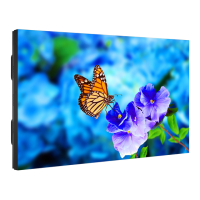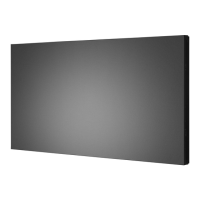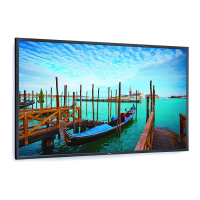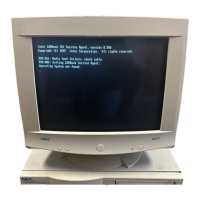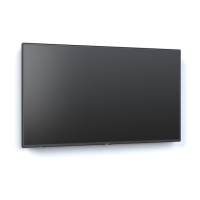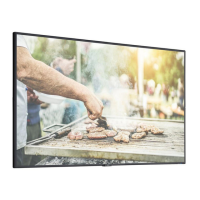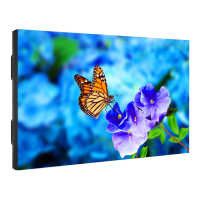
Do you have a question about the NEC MultiSync UN552V and is the answer not in the manual?
| Pixel pitch | 0.63 x 0.63 mm |
|---|---|
| Response time | 8 ms |
| Display diagonal | 55 \ |
| Display brightness | 500 cd/m² |
| Display technology | LED |
| Native aspect ratio | 16:9 |
| Vertical scan range | 23 - 86 Hz |
| Horizontal scan range | 26 - 134 kHz |
| Contrast ratio (typical) | 1700:1 |
| Display diagonal (metric) | 138.78 cm |
| Active display area (W x H) | 1209.63 x 680.34 mm |
| Operating hours (hours/days) | 24/7 |
| Maximum refresh rate | 60 Hz |
| Annual energy consumption | 328 kWh |
| Purpose | Universal |
| Orientation | Horizontal/Vertical |
| Product color | Black |
| Product design | Video wall |
| Placement supported | Indoor |
| Bezel width (bottom) | 0.44 mm |
| Panel mounting interface | 400 x 400 mm |
| USB ports quantity | 5 |
| DisplayPorts quantity | 3 |
| Compatible memory cards | MicroSD (TransFlash) |
| Ethernet LAN data rates | 10, 100 Mbit/s |
| VGA (D-Sub) input ports | 1 |
| HDMI input ports quantity | 2 |
| Audio formats supported | AAC, MP3, WAV |
| Image formats supported | JPG, PNG |
| Video formats supported | FLV, H.264, MOV, MP4, MPG, WMV |
| Power consumption (standby) | 0.5 W |
| Power consumption (typical) | 225 W |
| Storage temperature (T-T) | -20 - 60 °C |
| Operating temperature (T-T) | 0 - 40 °C |
| Storage relative humidity (H-H) | 10 - 90 % |
| Operating relative humidity (H-H) | 20 - 80 % |
| Certification | BSMI; CE; EAC; EMC B; FCC; PSB; RCM; REACH; RoHS; SASO; TÜV GS; TÜV S; UL/C-UL; VCCI |
| Sustainability certificates | RoHS |
| Cables included | AC, DisplayPort, HDMI |
| Harmonized System (HS) code | 85285210 |
| Depth | 98.6 mm |
|---|---|
| Width | 1210.5 mm |
| Height | 681.2 mm |
| Weight | 25800 g |
Provides a step-by-step guide to monitor setup, including location determination and remote control battery installation.
Details on how to safely mount the monitor, including precautions for customers and qualified personnel.
Specifies necessary space around the monitor for heat dissipation, especially in enclosed areas or ceiling mounts.
Identifies and explains the functions of each button on the monitor's control panel.
Details all input and output connectors on the monitor, including USB, HDMI, DisplayPort, and audio.
Describes the functions of each button on the wireless remote control for monitor operation.
Explains different video input types like Composite, VGA, DVI, HDMI, and DisplayPort.
Provides guidance on connecting PCs via various interfaces and typical signal timings.
Details connecting media players via HDMI for high-quality audio and video.
Explains monitor power states and LED indicator patterns for status monitoring.
Guides on cycling through available picture modes for optimal viewing.
Describes how to adjust the screen image's aspect ratio for different input signals.
Details SpectraView Engine features for color calibration and advanced settings.
Explains how to configure Picture-In-Picture (PIP) and Picture-By-Picture (PBP) modes.
Covers setting passwords and locking monitor control panel or remote buttons.
Guides on chaining monitors for video walls using communication and video connections.
Details signal output capabilities, including DisplayPort and HDMI, for multi-monitor setups.
Explains how to use the REMOTE CONTROL ID mode to control individual monitors.
Provides interface specifications for RS-232C and LAN connections for external control.
Details connecting a PC via RS-232C terminal for monitor control functions.
Explains network connection via LAN for remote control using an HTTP browser.
Addresses common problems like no picture, snowy images, and unstable display.
Provides solutions for issues like unresponsive buttons, no sound, or remote control malfunctions.
Explains image persistence and provides recommendations to prevent it and ensure long display life.
Lists detailed technical specifications for the UN552 model.
Lists detailed technical specifications for the UN552V model.
Provides links to regional websites for support and product information.
Lists PDF documents and SDKs for external control and Raspberry Pi integration.
Lists OSD controls related to selecting input signal sources.
Details OSD controls for picture modes, color settings, and display adjustments.
Lists OSD controls for adjusting volume, balance, equalizer, and audio inputs.
Provides information and links for environmentally sensitive disposal of used products.
Explains the monitor's advanced energy-saving capability and how it is activated.
